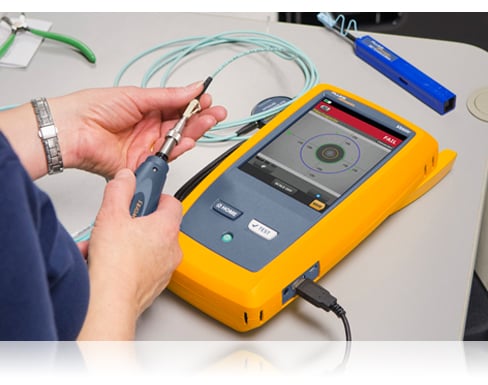All You Required to Understand About Robotic Vision and Its Applications in Advanced Optical Dimension Solutions
Robotic vision stands for a substantial development in the intersection of computer system vision, expert system, and artificial intelligence. This modern technology boosts the accuracy of optical dimension systems, allowing real-time information evaluation and boosted quality control. Its effect covers multiple markets, from making to health care. Nevertheless, the progressing landscape of robotic vision questions regarding future capacities and applications (optical fibre diameter analyser). What advancements exist ahead in this transformative field?
Understanding Robotic Vision: Trick Concepts and Technologies
Robotic vision encompasses the technologies and methodologies that allow machines to translate and comprehend visual info from their atmosphere. This field incorporates components of computer vision, fabricated intelligence, and equipment learning to facilitate automated decision-making based on visual information. Trick principles consist of image processing, which entails the improvement and analysis of images to draw out purposeful functions, and object recognition, which permits equipments to determine and identify items within a scene.

The Combination of Robotic Vision With Optical Dimension Solutions
As industries significantly require precision and efficiency, the combination of robotic vision with optical dimension systems has become a transformative method. This harmony allows robots to perceive and analyze their surroundings, boosting the ability of optical dimension systems to examine and evaluate objects with unequaled precision. By outfitting optical sensors with advanced imaging modern technologies, robotic vision enables real-time information collection and handling, helping with instant changes to dimension criteria.
The mix empowers automated systems to identify variants in dimensions, surface area high quality, and positioning, which are essential in top quality control processes. Improved formulas, such as artificial intelligence, additional augment this combination by improving the systems' capability to adapt to various atmospheres and scenarios. The integration not only streamlines dimension processes yet likewise minimizes mistakes, ensuring that items satisfy stringent industry criteria, thus strengthening the role of robotic vision in the future of optical measurement systems.
Applications of Robotic Vision in Production
In modern-day production settings, the use of vision systems has actually reinvented production procedures by making it possible for devices to do tasks with exceptional precision and speed. Robotic vision systems are increasingly used for high quality control, where they examine products for problems and warranty adherence to requirements. These systems use electronic cameras and advanced formulas to assess products in real-time, considerably reducing the threat of human mistake.
In addition, robot vision promotes automation in production line, permitting robotics to accurately identify components and construct them with very little downtime. This innovation likewise improves inventory administration, as vision systems can check stock levels and find inconsistencies, assuring a seamless supply chain.
Robotic vision help in the application of wise factories, where information from vision systems can be integrated with other technologies to optimize process (robotic vision). On the whole, the applications of robotic vision in producing show its crucial duty in improving performance, quality, and efficiency across different markets
Robotic Vision in Medical Care: Revolutionizing Client Care

In rehabilitation, robot vision aids in keeping an eye on individual progress and tailoring treatment sessions to private needs. It sustains medical professionals by automating jobs such as data collection and person tracking, permitting more time to concentrate on straight person communication. Furthermore, robot vision improves telemedicine by enabling remote diagnosis and virtual assessments, linking websites the gap in between people and medical care suppliers. On the whole, the application of robot vision in health care is changing client treatment, causing boosted end results, performance, and individual fulfillment.
Future Patterns and Growths in Robotic Vision Innovation
The fast development of robotic vision technology assures to better boost its applications across different industries, special info consisting of medical care. Future patterns indicate a considerable shift towards including artificial knowledge and equipment discovering, making it possible for systems to learn from substantial datasets and boost precision over time. Enhanced sensor innovations and deep discovering algorithms are expected to refine things recognition capacities, permitting robots to analyze complex atmospheres better.

The combination of increased reality (AR) with robotic vision will likely revolutionize exactly how robotics aid in surgical procedures and diagnostics. This harmony will certainly promote real-time data visualization, boosting decision-making procedures. Furthermore, miniaturization of elements will result in more compact and flexible robotic vision systems ideal for a variety of jobs. As these innovations unfold, industries will certainly witness enhanced automation and efficiency, solidifying robot vision as a cornerstone of innovative technical options.
Often Asked Inquiries
What Are the Main Components of a Robotic Vision System?
The main elements of a robotic vision system include electronic cameras for photo capture, processors for data evaluation, algorithms for interpretation, and actuators for movement. Together, these aspects enable robots to regard and communicate with their atmosphere efficiently.
Just How Does Robotic Vision Improve Accuracy in Measurements?
Robotic vision boosts dimension precision by utilizing advanced imaging technologies, allowing exact item detection and spatial evaluation. This ability reduces human error, raises repeatability, and allows for real-time changes, ultimately improving total measurement integrity and effectiveness.
What Industries Benefit Most From Robotic Vision Modern Technology?
Various sectors benefit considerably from robot vision modern technology, including manufacturing, health care, farming, and logistics. These sectors use boosted precision, efficiency, and automation, resulting in enhanced efficiency and reduced operational expenses in their respective processes.
Can Robotic Vision Systems Operate In Low-Light Conditions?
Robotic vision systems can indeed operate in low-light problems, using advanced sensors and check this formulas to improve photo clarity. This ability allows them to do efficiently in different atmospheres, consisting of commercial and surveillance applications, despite marginal illumination.
What Are the Prices Linked With Executing Robotic Vision?
The expenses related to implementing robot vision differ substantially, influenced by elements such as video cameras, software application, and integration. Added expenses include upkeep, training workers, and prospective upgrades to existing systems, which can accumulate gradually.